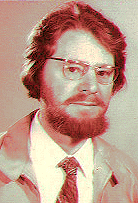 BELL'S THEOREM
BELL'S THEOREM
BELL'S THEOREM PROVES PHYSICAL REALITY MUST BE NON-LOCAL.
One way of conceptualizing the world is the ART schema proposed by
Immanuel Kant and others where ART stands for Appearance, Reality and Theory.
Appearance is the facts of experience, both inner and outer, Reality is
the hidden causes behind these Appearances, and Theory is the stories we
tell one another about both Appearance and Reality.
Physics concerns itself only with outer experiences not inner and the primary
physics Story About Appearances is Quantum Theory which describes without
error the complete range of Quantum Facts. A particular class of quantum
facts concerns the EPR experiment
(named after Einstein, Podolski and Rosen) in which two quantum particles
A and B which were once together fly apart and are measured at two distant
locations A and B.
In the Quantum Theory, observer A's choice of what kind of measurement to
make on particle A instantly changes the state description of particle B--a
general feature of quantum theory called "quantum phase entanglement".
In the theory a particle is represented by possibility amplitudes and relative
phases. When the particles separate, so do the amplitudes, but the phases
of particle A remain entangled with the phases of particle B. Any action
on A--such as an observation--changes not only A's phases but the phases
of B as well.
This action of observer A on distant particle B does not diminish with distance,
cannot be shielded and travels faster than light. This (in theory) distant
influence is unmediated, unmitigated and immediate. This (in theory) quantum
connection between two particles once together now apart is a lot like voodoo--no
known force connects particles A and B--just the fact of their once being
together suffices to mingle their phases.
(In the jargon of physics such instant voodoo influences are called "non-local";
all ordinary light-speed-limited forces are called "local")
But this non-local connection only exists in (the admittedly powerful) Theory.
In Appearance (the quantum facts) no action taken by observer A ever leads
to an observable effect (faster-than-light or otherwise) at location B.
Thus the quantum facts do not show an FTL (voodoo) connection. In line with
the apparent unobservability of instant links Quantum Theory itself despite
its internal representation of non-local links never allows these links
to surface as observable phenomena.
The Theory shows an instant connection twixt A and B; the Appearances do
not. What about Reality? Can we tell a story about invisible influences
behind the phenomena that leaves out the instant connection or must a non-local
connection be necessarily present in every Quantum Reality--every story
we can tell about the underlying causes of all possible experiments on separated
particles A and B?
Irish physicist John Stewart Bell considered the EPR system and showed with
a devilishly clever proof that all conceivable models of Reality must incorporate
this instant connection. What Bell showed is that despite the fact that
Relativity prohibits instantaneous connections, despite the fact that no
such connections have ever been observed either in EPR experiments or any
other, despite the fact that quantum theory itself predicts no observable
instant connections, despite all these considerations from Fact and Theory,
the Reality of the EPR particles is such that their initial contact must
create an instantaneous voodoo-style link between them below the level of
Appearances.
Bell's Theorem (Reality must be non-local)
is remarkable for several reasons: 1) it is a mathematical proof, not a
conjecture or speculation; 2) it is a proof about Reality not Appearances.
How often does one find such a window into the nature of reality? 3) it
is counter-intuitive: why should everywhere local facts need to be supported
by a non-local reality?
For more technical information about Bell's Proof, See "Quantum
Reality". For a good account of Bell's life and deeper quantum
issues see Jeremy Bernstein's excellent
account composed from interviews with Bell shortly before his death. Nick
Herbert devised the world's shortest proof of Bell's theorem (Nick's Proof:
versions One and Two)
. Goldberger, Horne and Zeilinger (GHZ)
generalized the two-particle EPR experiment to three or more particles and
came up with what is probably the most elegant proof (using only eigenstates:
quantum theory's deterministic subset) of nature's necessary non-locality.
BACK
usps://usa.ca/95006.bouldercreek/box261/nick.herbert
quanta@cruzio.com
 BELL'S THEOREM
BELL'S THEOREM